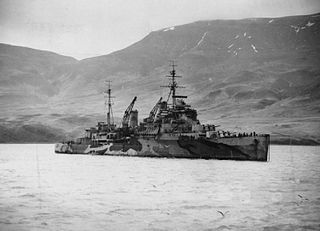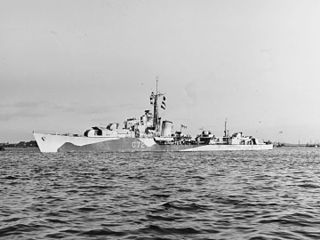Related Research Articles

The Battle of the North Cape was a Second World War naval battle that occurred on 26 December 1943, as part of the Arctic campaign. The German battleship Scharnhorst, on an operation to attack Arctic convoys of war materiel from the western Allies to the Soviet Union, was brought to battle and sunk by the Royal Navy's battleship HMS Duke of York with cruisers and destroyers, including an onslaught from the destroyer HNoMS Stord of the exiled Royal Norwegian Navy, off the North Cape, Norway.

The Arctic convoys of World War II were oceangoing convoys which sailed from the United Kingdom, Iceland, and North America to northern ports in the Soviet Union – primarily Arkhangelsk (Archangel) and Murmansk in Russia. There were 78 convoys between August 1941 and May 1945, sailing via several seas of the Atlantic and Arctic oceans, with two gaps with no sailings between July and September 1942, and March and November 1943.

PQ 13 was a British Arctic convoy that delivered war supplies from the Western Allies to the USSR during World War II. The convoy was subject to attack by German air, U-boat and surface forces and suffered the loss of five ships, plus one escort vessel. Fifteen ships arrived safely.

Convoy PQ 15 was an Arctic convoy sent from Iceland by the Western Allies to aid the Soviet Union during the Second World War. The convoy sailed in late April 1942, reaching the Soviet northern ports after air attacks that sank three ships out of twenty-five.
Convoy PQ 12 was an Arctic convoy sent from Great Britain by the Western Allies to aid the Soviet Union during World War II. It sailed in March 1942, reaching Murmansk despite a sortie against it by the German battleship Tirpitz. All ships arrived safely.
Convoy PQ 11 was an Arctic convoy sent from Great Britain by the Western Allies to aid the Soviet Union during World War II. It sailed in February 1942 and arrived in Murmansk without loss.

Convoy JW 58 was an Arctic convoy sent from Great Britain by the Western Allies to aid the Soviet Union during World War II. It sailed in March 1944, reaching the Soviet northern ports in early April. All ships arrived safely. JW 58 was attacked by German U-boat and aircraft but suffered no losses. Three U-boats were destroyed and six aircraft were shot down during these operations.

Convoy JW 57 was an Arctic convoy sent from Great Britain by the Western Allies to aid the Soviet Union during World War II. It sailed in February 1944, reaching the Soviet northern ports at the end of the month. All ships arrived safely. For several days JW 57 was attacked by a German U-boat force; one escort vessel was sunk, and two U-boats were destroyed in counter-measures, during this operation.
Convoy JW 56A was an Arctic convoy sent from Great Britain by the Western Allies to aid the Soviet Union during World War II. It sailed in January 1944, reaching the Soviet northern ports at the end of the month. Twelve ships arrived safely. During the voyage JW 56A was attacked by a German U-boat force; three ships were sunk and one of the escorts damaged in the operation.

Convoy JW 56B was an Arctic convoy sent from Great Britain by the Western Allies to aid the Soviet Union during World War II. It sailed in late January 1944, reaching the Soviet northern ports at the beginning of February. All ships arrived safely. During the voyage JW 56B was attacked by a German U-boat force; no merchant ships were sunk, though one of the escorts was lost. One attacking U-boat was destroyed in the operation.

Convoy JW 55B was an Arctic convoy sent from Great Britain by the Western Allies to aid the Soviet Union during World War II. It sailed in late December 1943, reaching the Soviet northern ports at the end of the month. All ships arrived safely.
Convoy RA 55A was an Arctic convoy during World War II. It was one of a series of convoys run to return Allied ships from Soviet northern ports to ports in Britain. It sailed in late December 1943, reaching British ports at the end of the month. All ships arrived safely.
Convoy RA 55B was an Arctic convoy during World War II. It was one of a series of convoys run to return Allied ships from Soviet northern ports to ports in Britain. It sailed at the end of December 1943, reaching British ports in early January 1944. All ships arrived safely.
Convoy JW 54A was an Arctic convoy sent from Great Britain by the Western Allies to aid the Soviet Union during World War II. It sailed in November 1943, reaching the Soviet northern ports at the end of the month. JW 54A was the first out-bound Arctic convoy of the 1943–44 winter season, following their suspension during the summer. All ships arrived safely.
Convoy JW 54B was an Arctic convoy sent from Great Britain by the Western Allies to aid the Soviet Union during World War II. It sailed in late November 1943, reaching the Soviet northern ports at the end of the month. All ships arrived safely.
Convoy JW 51A was an Arctic convoy sent from Great Britain by the Western Allies to aid the Soviet Union during World War II. It sailed in December 1942, reaching the Soviet northern ports at the end of the month.
Convoy JW 51B was an Arctic convoy sent from United Kingdom by the Western Allies to aid the Soviet Union during World War II. It sailed in late December 1942, reaching the Soviet northern ports in early January 1943.
Convoy QP 15 was an Arctic convoy of the PQ/QP series which ran during the Second World War. It was one of a series of convoys run to return Allied ships to home ports in the United Kingdom from the northern ports of the Soviet Union.It sailed in November 1942 and was the last convoy in the "QP" series. It was scattered by a storm which sank the Soviet destroyer Sokrushitelny and was attacked by U-boats of the German Navy which sank two of the thirty merchant ships.

HMS Scorpion was an S-class destroyer of the Royal Navy, the eleventh of her name, commissioned on 11 May 1943. Initially she was to be named Sentinel, but this was changed following the loss of the Dragonfly-class river gunboatScorpion in the Bangka Strait in February 1942. She served in the Royal Navy during the Second World War, mostly in the Arctic Ocean, and fought in the Battle of North Cape. She was sold to the Netherlands in 1945 and scrapped in 1963.

HMS Dianella was a Flower-class corvette of the Royal Navy. She served during the Second World War.
References
- Blair, Clay (1998). Hitler's U-Boat War: The Hunted 1942-1945. ISBN 0-304-35261-6.
- Paul Kemp : Convoy! Drama in Arctic Waters (1993) ISBN 1-85409-130-1
- Kemp, Paul (1997). U-Boats Destroyed, German submarine losses in the World Wars. Arms and Armour. ISBN 1-85409-515-3.
- Niestle, Axel (1998). German U-Boat Losses During World War II. Greenhill. ISBN 1-85367-352-8.
- Bob Ruegg, Arnold Hague : Convoys to Russia (1992) ISBN 0-905617-66-5
- Bernard Schofield : (1964) The Russian Convoys BT Batsford ISBN (none)
- JW 55A at Convoyweb